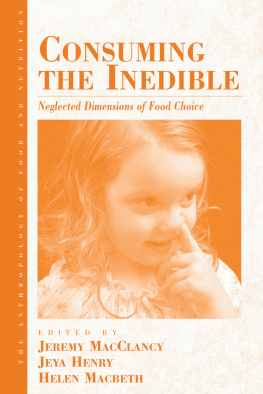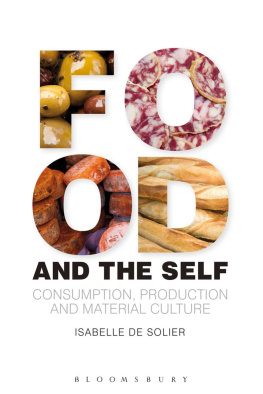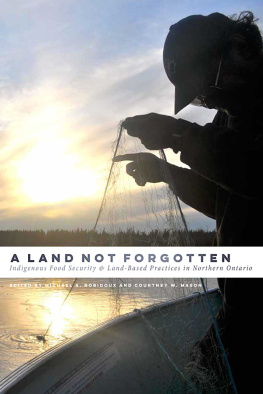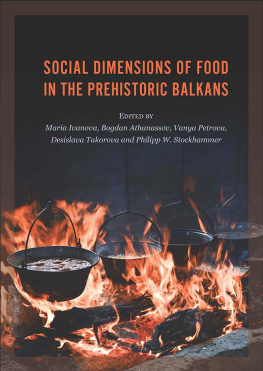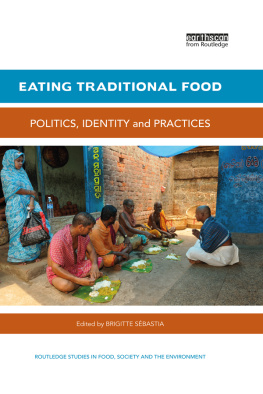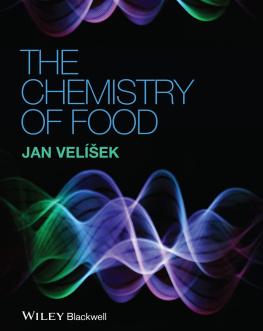AFTERWORD
EARTHY REALISM: GEOPHAGIA IN LITERATURE AND ART
Jeremy MacClancy
A nthropology, by definition, has no geographical limits. We research ourselves and others anywhere on the globe. Moreover, as an almost boundless discipline, anthropology has remarkably few intellectual limits. So long as the topic of study is social, in one dimension or another, its investigation can usually fit within the remit of our remarkably broad discipline.
Geophagia is no exception. We investigate its incidence, nature and contexts wherever it occurs (see, e.g., the relevant chapters in this volume). And just because eating earth is not a common-day or customary practice in the modern West does not mean there is not a topic here for us to study. In fact, the very opposite: for in order to gain a more rounded idea of Western conceptions and approaches to geophagia, we need to look at popular modes of representing the practice to Western audiences. That is the aim of this contribution. I start with its occurrence in novels, then move on to illustrations.
Literary Representations
The first point has to be that there are so few references to geophagia in literature. I have, over the past two years, repeatedly badgered friends, colleagues and associates in neighbouring disciplines for examples, only to trawl a meagre shoal. It is possible that there are a host of references in the indigenous literatures of the areas where it is most practised (Africa, Asia, the American South), but I have yet to learn of them.
The earliest reference I found is from John Steinbeck's great novel of the labour-migrant Okies, The Grapes of Wrath (Steinbeck 1939). Impoverished, under-nourished, these poor whites trek to California only to find that a sustained, gross exploitation is their most likely lot. One evening, the matriarch of the novel's main family notices her malnourished, pregnant daughter eating something:
What you nibblin on?
Jus' a piece a slack lime. Foun' a big hunk.
Why, tha's jus' like eatin' dirt.
I kinda feel like I wan' it.
The matriarch controls her physical reaction, then confesses that she had done similar things herself when pregnant: eaten a big piece a coal and been admonished by her mother. The daughter makes her predicament plain: Got no husban! Got no milk!'. Her mother replies that it is only her daughter's state which stops her from hitting her (1939: 309).
Perhaps the most striking point here is that Steinbeck clearly does not wish to sensationalise the activity. On the contrary, he appears to present it as just another behaviour of the group he is describing: the dust-bowl migrants of the 1930s. In this sense, it is but a further item in their sorry list of activities. Steinbeck seems to be acknowledging the liminal status of this sort of consumption: it is both recognised and devalued; accepted and discouraged. Whether it is to be taken as distinctive of the poor is left unclear. If it is meant to be understood in that vein, then Steinbeck appears to have included it as a way to inform middle-class readers of what the rural impoverished get up to. Further, it may have even been a way for this campaigning novelist to remind his leisured readers that geophagia was emphatically not a past custom, but a living one in the United States of their time, and thus an added reason for condemning the contemporary social injustices suffered in the land.
Next comes Lionel Shriver's The Female of the Species (Shriver 1988), a tale of a female anthropologist who lives among an isolated African people denigrated by their neighbours. To the Masaai, these isolates are worthy only of derision:
(The) Il-Ororen of the Puddle had grown superstitious and easily awedThey had eaten clay for too long and their smiths made dull arrows, their women made pots with holes; their minds would hold no more cleverness than their pots would hold water. They had forgotten how to raid and be warriors. (Shriver 1988: 2122)
Shriver uses geophagia as cross-tribal put-down. It is made an ethnic slur by a Masaai pastoralist who prided himself a warrior and drinker of livestock-blood. Fighters are not made of clay. Earth they leave for unconstrained agriculturalists with no self-respect. Once again, there is no sensationalism here; geophagia is accepted as a local custom; it is just not one for males who wish to be men.
Barbara Kingsolver's The Poisonwood Bible, published the next year, is an epic novel about an evangelical missionary's tribulations in post-independence Congo, narrated by his wife and daughters. In the Congo, one of the girls observes the desperate reactions of mothers who lose their children in an epidemic:
Inside a grove of trees the mothers threw themselves on mounds of dirt that covered their children. Crawled on their hands and knees, tried to eat the dirt from the graves. Other women had to pull them away. (Kingsolver 1989: 336)
Years later, another daughter, now a student in the USA, finds this scene returns in her dreams. Here it serves as a potent reminder of how local children died and, by corollary, how her baby sister perished in the village. Why did she die, and not another sister? The survivor can think of no answer (p. 468). Thirty pages later, she takes her half-Congolese niece to an Atlanta supermarket. The child scans the shelves, then asks her
But, Aunt Adah, how can there be so many kinds of things a person doesn't need?
I can think of no honourable answer. Why must some of us deliberate between brands of toothpaste, while others deliberate between damp dirt and bone dust to quiet the fire of an empty stomach lining? (p. 498).
Kingsolver uses dirt-eating here as a contrast between the States and the Congo, between an overstocked affluence and a need-driven desperation. For her, it is an index of the radical differences between the two areas. To this extent, her literary deployment of geophagia could be seen as a mild sensationalism, an extra-lively means of underscoring the gap between the wasteful riches of the West and the grubbing of Africans in the soil beneath their feet, in order to survive. The morality of the contrast is heightened by Kingsolver's use of dirt rather than earth, and then reinforced by reference to bone dust, almost animal-like in the images it calls up.
And yet, this transatlantic, transeconomic, cross-cultural contrast is undercut by the mother's reference, earlier in the novel, to doing the same herself, years before. She remembers she was brought up poor, in Mississippi, and innocent of the world beyond. Married at seventeen to a Free Will Baptist and soon pregnant, she finds her new condition troubling: When I was carrying the twins I had such desperate cravings I sometimes went out at night on my hands and knees and secretly ate dirt from the garden (Kingsolver 1989: 226). Thus Kingsolver uses geophagia to both divide and unite: to underline the material difference between a wealthy West and an impoverished Africa, and at the same time, to bring together women, whether grieving Congolese mothers or a pregnant Southerner, in their common, female despair. In this sense geophagia can play an edgy, double role, which Kingsolver uses to powerful, pedagogic effect.
The most famous literary use of geophagia, however, is not by a US writer, but by a Latin American one, Gabriel Garca Mrquez, in his celebrated One Hundred Years of Solitude. Rebeca, a distant relative of obscure origin, who appears not to speak Castilian but an Indian tongue, is adopted by the novel's central family. All she eats are the damp earth of the courtyard and the cake of whitewash that she picked off the wallsWhoever had raised her had scolded her for that habit because she did it secretively and with a feeling of guilt (Garca Mrquez 1970: 43). The family manage to cure Rebeca of her pernicious vice and she appears to settle down and grow up as a normal girl. When an adolescent, she falls in love. But her lover's letters stop arriving.
Next page
